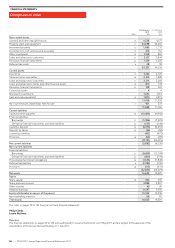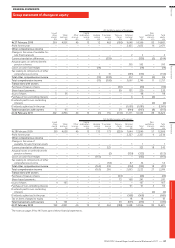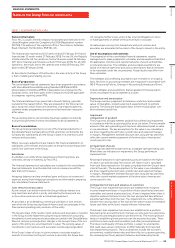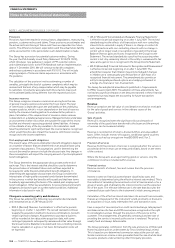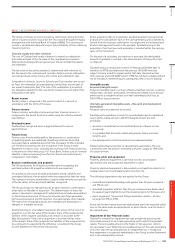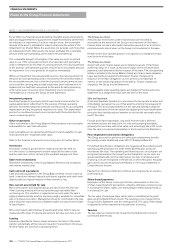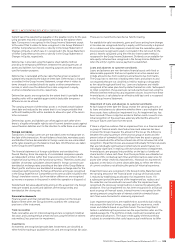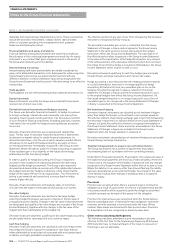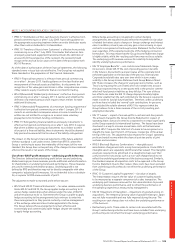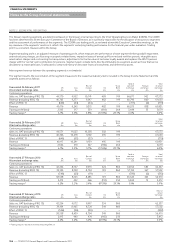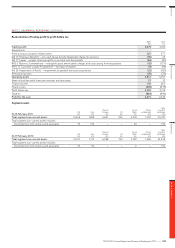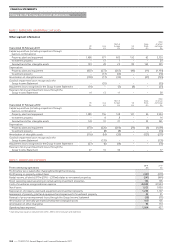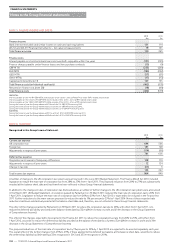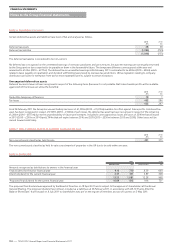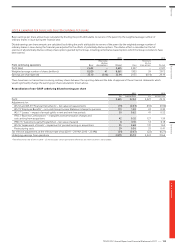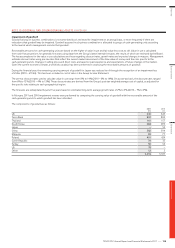Tesco 2011 Annual Report Download - page 109
Download and view the complete annual report
Please find page 109 of the 2011 Tesco annual report below. You can navigate through the pages in the report by either clicking on the pages listed below, or by using the keyword search tool below to find specific information within the annual report.
• IFRIC 17 ‘Distributions of Non-cash Assets to Owners’ is effective from
periods commencing on or after 1 July 2009. It provides guidance on
the appropriate accounting treatment when an entity distributes assets
other than cash as dividends to its shareholders.
• IFRIC 18 ‘Transfers of Assets from Customers’ is effective from periods
commencing on or after 1 July 2009. It concludes that when an item
of property, plant and equipment transferred meets the definition of
an asset from the perspective of the recipient, the recipient should
recognise the asset at its fair value on the date of the accordance with
IAS 18 ‘Revenue’.
As of the date of authorisation of these financial statements, the following
standards were in issue but not yet effective. The Group has not applied
these standards in the preparation of the financial statements:
• IFRS 9 ‘Financial Instruments’ is effective from periods commencing
on or after 1 January 2013. It adds guidance on the classification and
measurement of financial assets and liabilities. It only permits the
recognition of fair value gains and losses in other comprehensive income
if they relate to equity investments that are not held for trading.
• IAS 24 (Amended) ‘Related party disclosures’ is effective from periods
commencing on or after 1 January 2011. It clarifies and simplifies the
definition of a related party and will require certain entities to make
additional disclosures.
• IFRIC 14 (Amended) ‘Prepayments of a minimum funding requirement’
is effective from periods commencing on or after 1 January 2011. It
corrects an unintended consequence where in some circumstances
entities are not entitled to recognise as an asset some voluntary
prepayments for minimum funding contributions.
• IFRIC 19 ‘Extinguishing financial liabilities and equity instruments’ is
effective from periods commencing on or after 1 July 2010. It requires
that where a debtor issues equity instruments to a creditor to settle
all or part of a financial liability, these instruments should be deemed
fully paid and measured at the fair value of the liability extinguished.
The impact on the Group’s financial statements of the future adoption
of these standards is still under review. Other than IFRS 9, where the
Group is continuing to assess the materiality of the impact of this new
standard, the Group does not expect any of the changes to have material
effect on the result or net assets of the Group.
Use of non-GAAP profit measures – underlying profit before tax
The Directors believe that underlying profit before tax and underlying
diluted earnings per share measures provide additional useful information
for shareholders on underlying trends and performance. These measures
are used for internal performance analysis. Underlying profit is not
defined by IFRS and therefore may not be directly comparable with other
companies’ adjusted profit measures. It is not intended to be a substitute
for, or superior to IFRS measurements of profit.
The adjustments made to reported profit before tax are:
• IAS 32 and IAS 39 ‘Financial Instruments’ – fair value remeasurements.
Under IAS 32 and IAS 39, the Group applies hedge accounting to its
various hedge relationships when allowed under the rules of IAS 39
and when practical to do so. Sometimes the Group is unable to apply
hedge accounting to the arrangements but continues to enter into
these arrangements as they provide certainty or active management
of the exchange rates and interest rates applicable to the Group.
The Group believes these arrangements remain effective and
economically and commercially viable hedges despite the inability
to apply hedge accounting.
Where hedge accounting is not applied to certain hedging
arrangements, the reported results reflect the movement in fair value
of related derivatives due to changes in foreign exchange and interest
rates. In addition, at each year end, any gain or loss accruing on open
contracts is recognised in the Group Income Statement for the financial
year, regardless of the expected outcome of the hedging contract on
termination. This may mean that the Group Income Statement charge
is highly volatile, whilst the resulting cash flows may not be as volatile.
The underlying profit measure removes this volatility to help better
identify underlying business performance.
• IAS 19 ‘Employee Benefits’ – non-cash Income Statement charge
for pensions. Under IAS 19 the cost of providing pension benefits
in the future is discounted to a present value at the corporate bond
yield rates applicable on the last day of the previous financial year.
Corporate bond yield rates vary over time which in turn creates
volatility in the Group Income Statement and Group Balance Sheet.
IAS 19 also increases the charge for young pension schemes, such as
Tesco’s, by requiring the use of rates which do not take into account
the future expected returns on the assets held in the pension scheme
which will fund pension liabilities as they fall due. The sum of these
two effects can make the IAS 19 charge disproportionately higher
and more volatile than the cash contributions the Group is required to
make in order to fund all future liabilities. Therefore, within underlying
profit we have included the ‘normal’ cash contributions for pensions
but excluded the volatile element of IAS 19 to represent what the
Group believes to be a fairer measure of the cost of providing post-
employment benefits.
• IAS 17 ‘Leases’ – impact of annual uplifts in rent and rent-free periods.
The amount charged to the Group Income Statement in respect of
operating lease costs and incentives is expected to increase significantly
as the Group expands its international business. The leases have been
structured in a way to increase annual lease costs as the businesses
expand. IAS 17 requires the total cost of a lease to be recognised on a
straight-line basis over the term of the lease, irrespective of the actual
timing of the cost. This adjustment also impacts the Group’s operating
profit and rental income within the share of post-tax profits of joint
ventures and associates.
• IFRS 3 (Revised) ‘Business Combinations’ – intangible asset
amortisation charges and costs arising from acquisitions. Under IFRS 3
intangible assets are separately identified and fair valued. The intangible
assets are required to be amortised on a straight-line basis over their
useful economic lives and as such is a non-cash charge that does not
reflect the underlying performance of the business acquired. Similarly,
the standard requires all acquisition costs to be expensed in the Group
Income Statement. Due to their nature, these costs have been excluded
from underlying profit as they do not reflect the underlying performance
of the Group.
• IFRIC 13 ‘Customer Loyalty Programmes’ – fair value of awards.
The interpretation requires the fair value of customer loyalty awards
to be measured as a separate component of a sales transaction. The
underlying profit measure removes this fair value allocation to present
underlying business performance, and to reflect the performance of
the operating segments as measured by management.
• IAS 36 ‘Impairment of Intangibles’ – impairment of goodwill arising on
acquisitions. The remaining carrying value of goodwill relating to Japan
was not fully recoverable and was fully impaired during the year. The
resulting non-cash charge does not reflect the underlying performance
of the business.
• Restructuring costs. These relate to certain costs associated with the
Group’s restructuring activities and have been excluded from underlying
profit as they do not reflect the Group’s underlying performance.
NOTE 1 ACCOUNTING POLICIES CONTINUED
TESCO PLC Annual Report and Financial Statements 2011
—
105
Overview Business review Governance Financial statements



